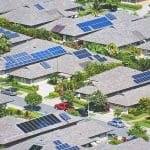Installing a solar panel system is not as easy as buying a solar panel and plugging it in. Companies that sell solar panel kits give you the main components that you will need to set one up, but what they often neglect to tell you is that you will most likely need several more items to get your kit up and running. In this article, we are going to look at what a professional solar panel system looks like and all of the parts involved.
Core Components
The core components are what is usually included in a solar panel installation kit. These are the main, most expensive items one needs to get their setup up and running; however, as we will see below, other accessories are needed to complete an installation. Let’s look at the main parts of a solar power system.
- Racking and Attachments
Regardless of whether panels will be installed on the ground or a roof, they need a racking or mounting kit. A mounting kit attaches to the solar panels themselves to lock them in place and keep them secure from a fall. This is the foundation of a solar power setup and is often the most difficult to install.
- Solar Panels
The solar panels consist of solar cells and are what convert the light from the sun into electricity. These are attached to the mounting system in a location where they will receive a sufficient amount of sunlight. Though we are talking about solar panel systems on a larger scale in this article, it is possible to purchase all-in-one solar power units. For example, it is possible to buy miniature solar panel kits for camping or mobile device charging that has everything necessary to provide power built in. With these kinds of units, you can directly plug your devices in and receive power.
- Inverters
Without getting too technical, an inverter converts DC to AC power so that your panels can send energy to your home breaker box. If one is looking to use their panels to supplement the power going into their house, this is a vital component. Of course, solar panels can be used without an inverter, but they will not be able to feed directly into a house’s primary power source.
Other Necessary Components
The components that are often overlooked in a solar panel setup revolve around the wiring accessories. A lot of kits will not include what is needed to completely wire a configuration, as each person’s home will have different requirements. The length of the wire alone is highly variable from home to home, and this is where things can get tricky.
A solar power system requires enough wire to run from place to place along with various fittings to accommodate its route to a home’s main circuit breaker. Again, the length of cable as well as the number and types of accessories needed is variable and will require some homework. Additionally, the wires need shielding from the outside elements, and this is where conduits and junction boxes come into play. Conduits shield the wires as they run from place to place while junction boxes shield them where they connect to the solar panels and prevent power from feeding back to them. And finally, depending on how a particular house is wired, extra breakers or AC/DC disconnects may be necessary.
Conclusion
As you can see, a solar panel system consists of a lot of components and can be quite challenging to set up if one is not well-versed in electrical engineering. To sum things up, solar panels convert the sun’s light into electricity, and the electricity is fed via shielded wires where it is eventually converted to AC power with an inverter that taps into a breaker box. Hopefully, this article has given you some insight on what all is needed to assemble a functional one and has left you with a deeper understanding of how all of the pieces work together to take advantage of the power of the sun.





